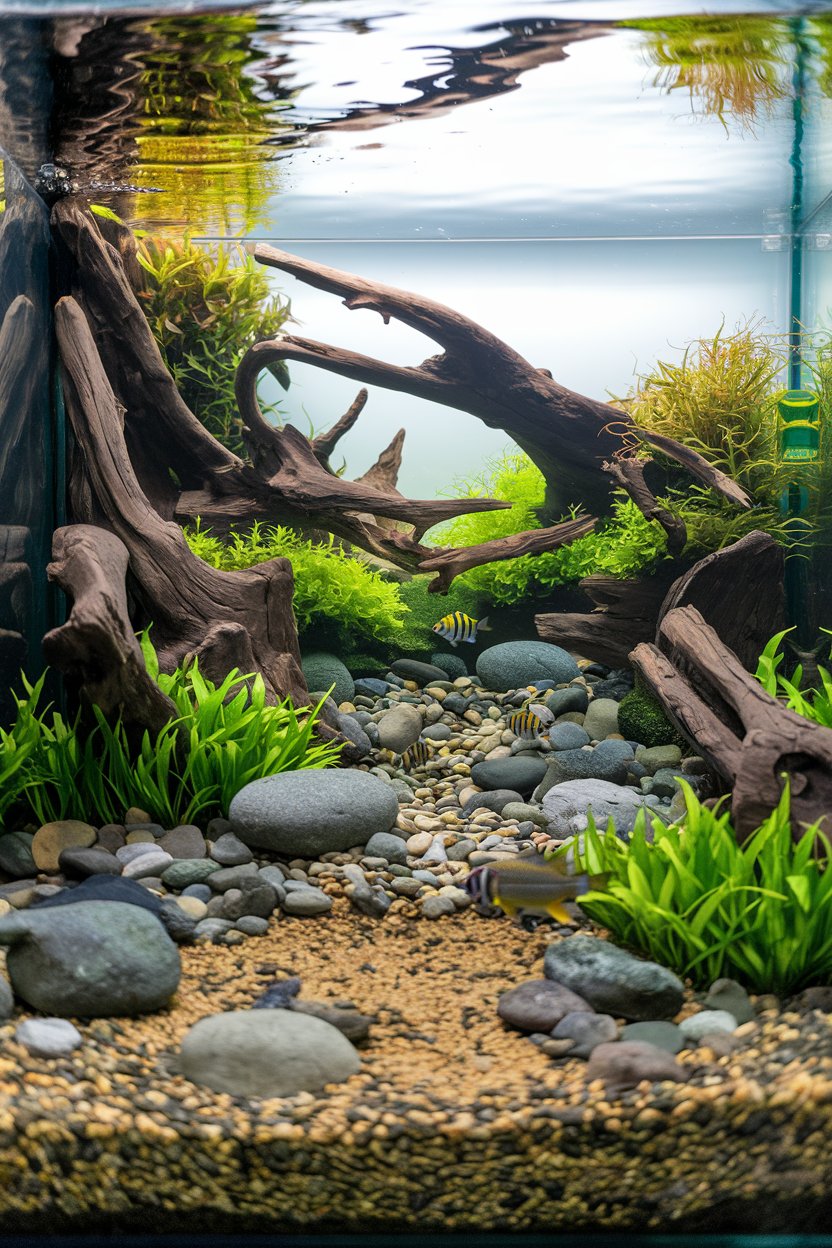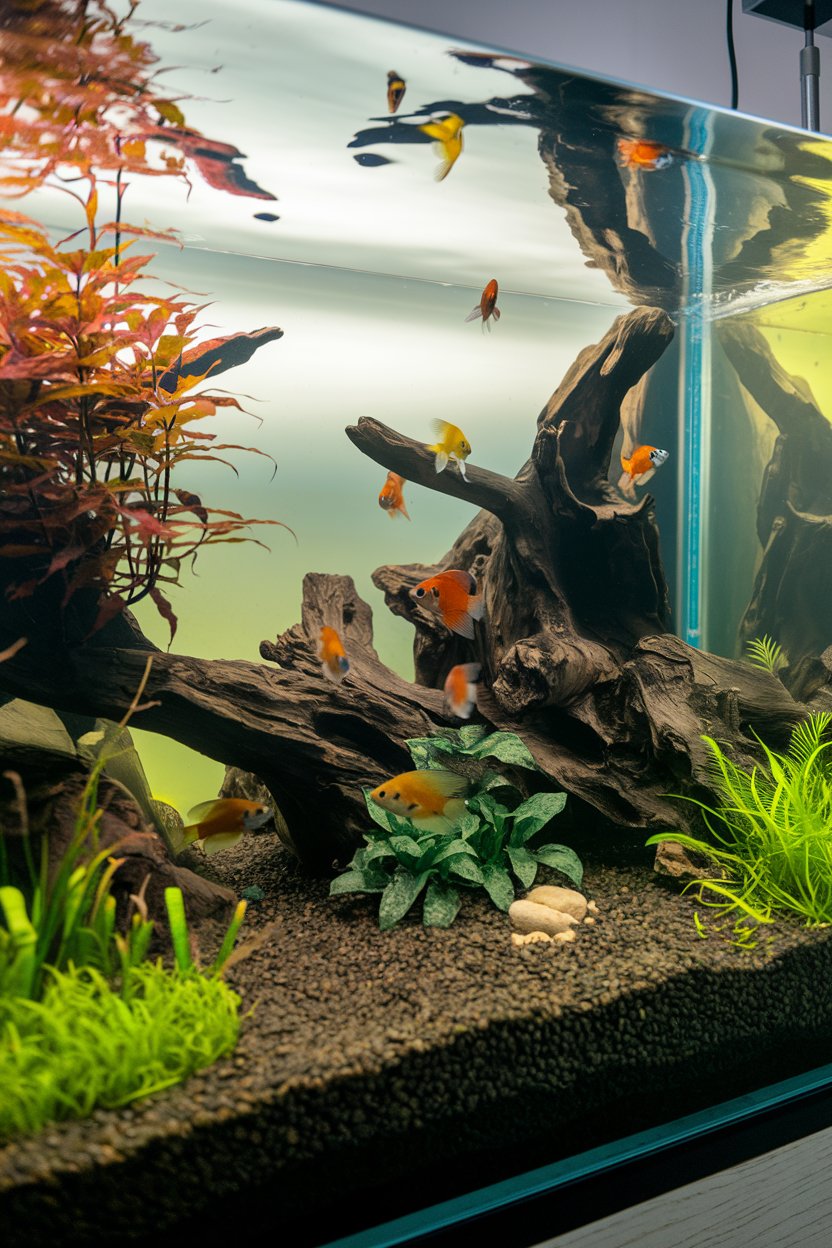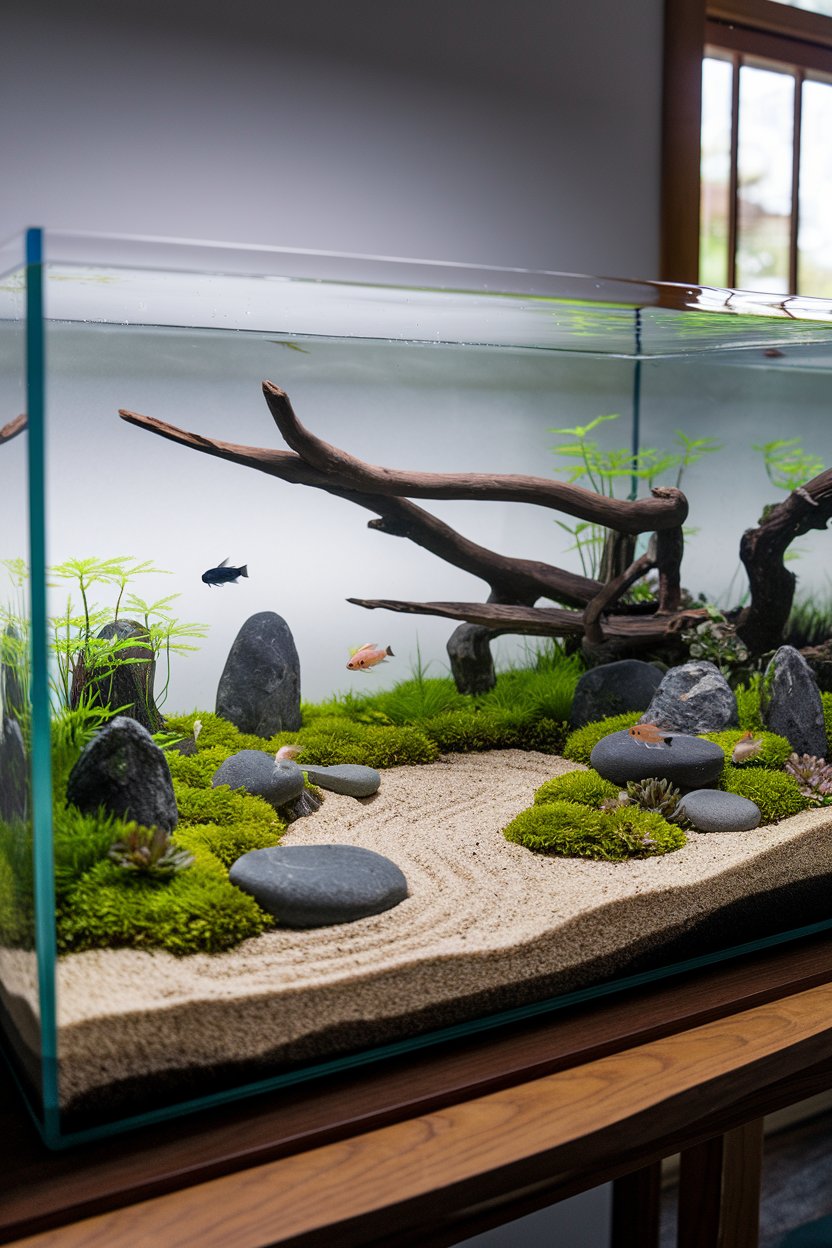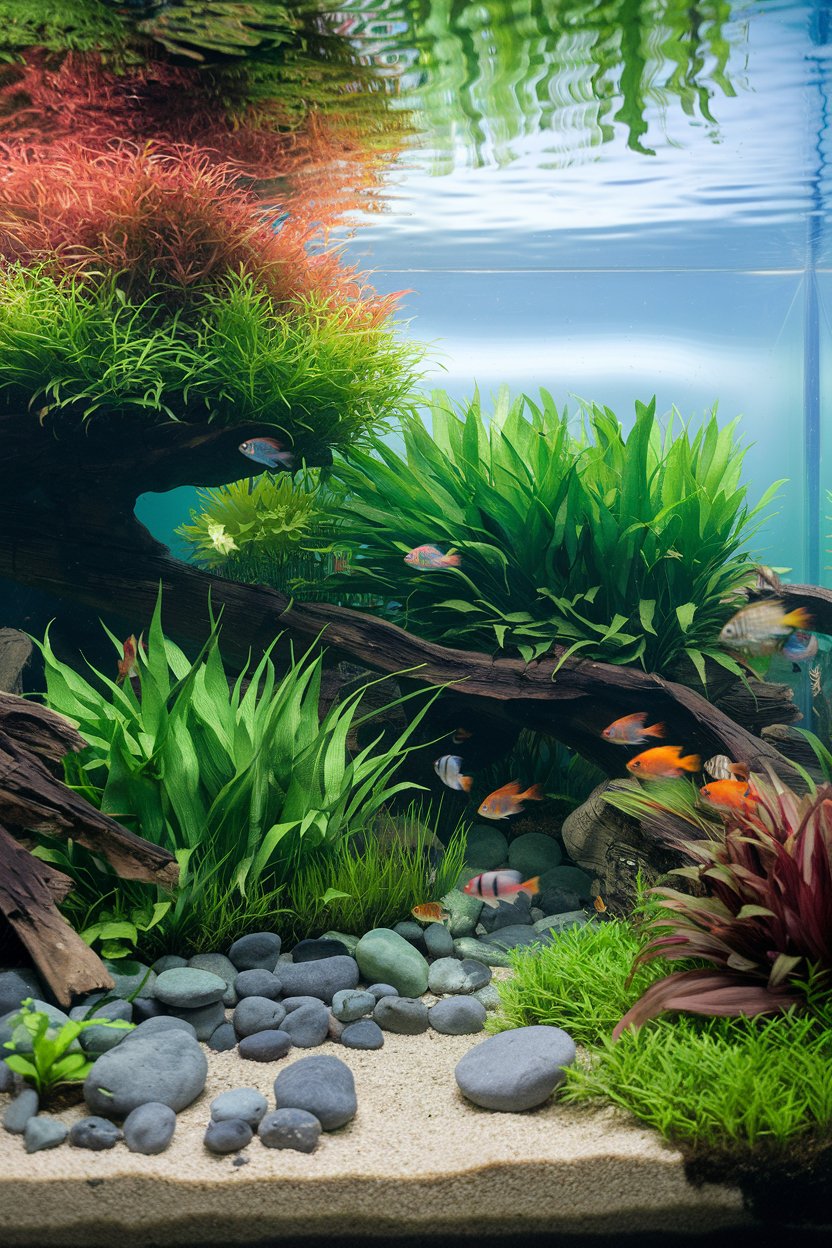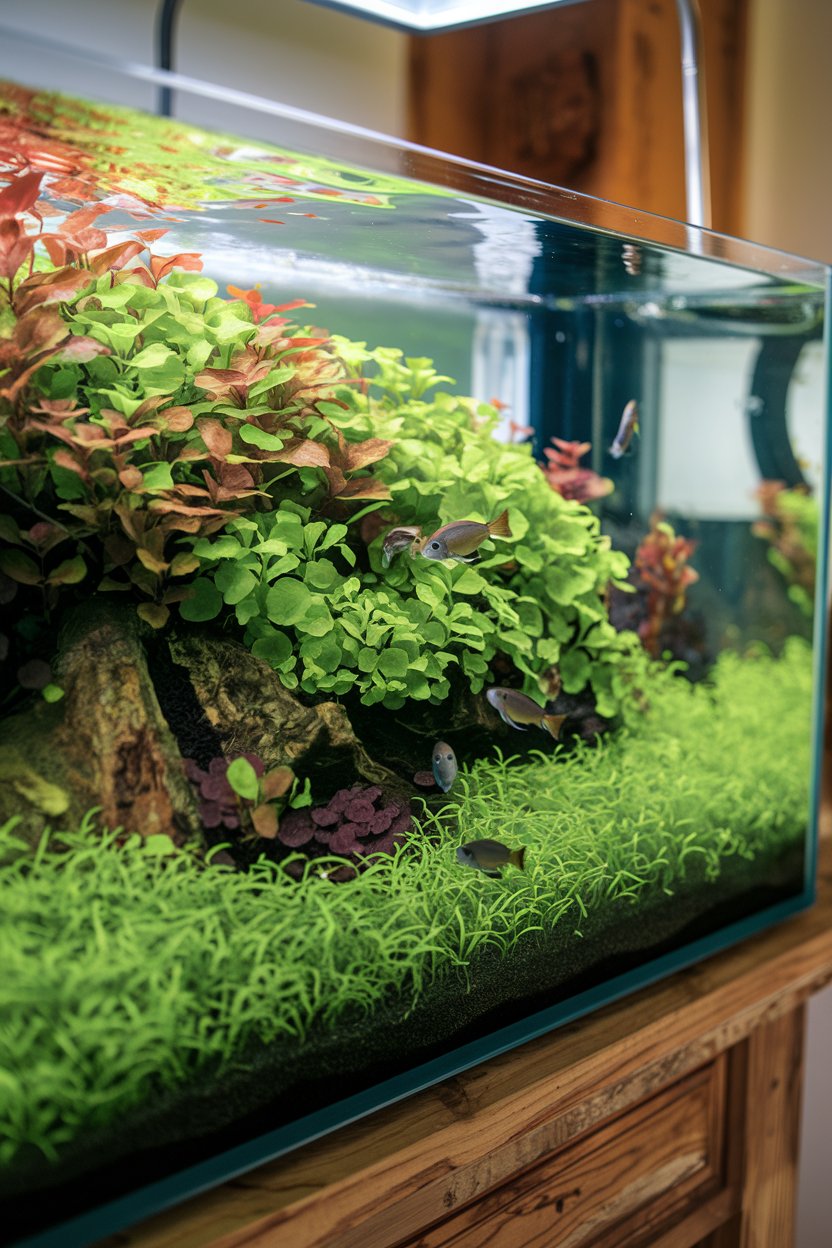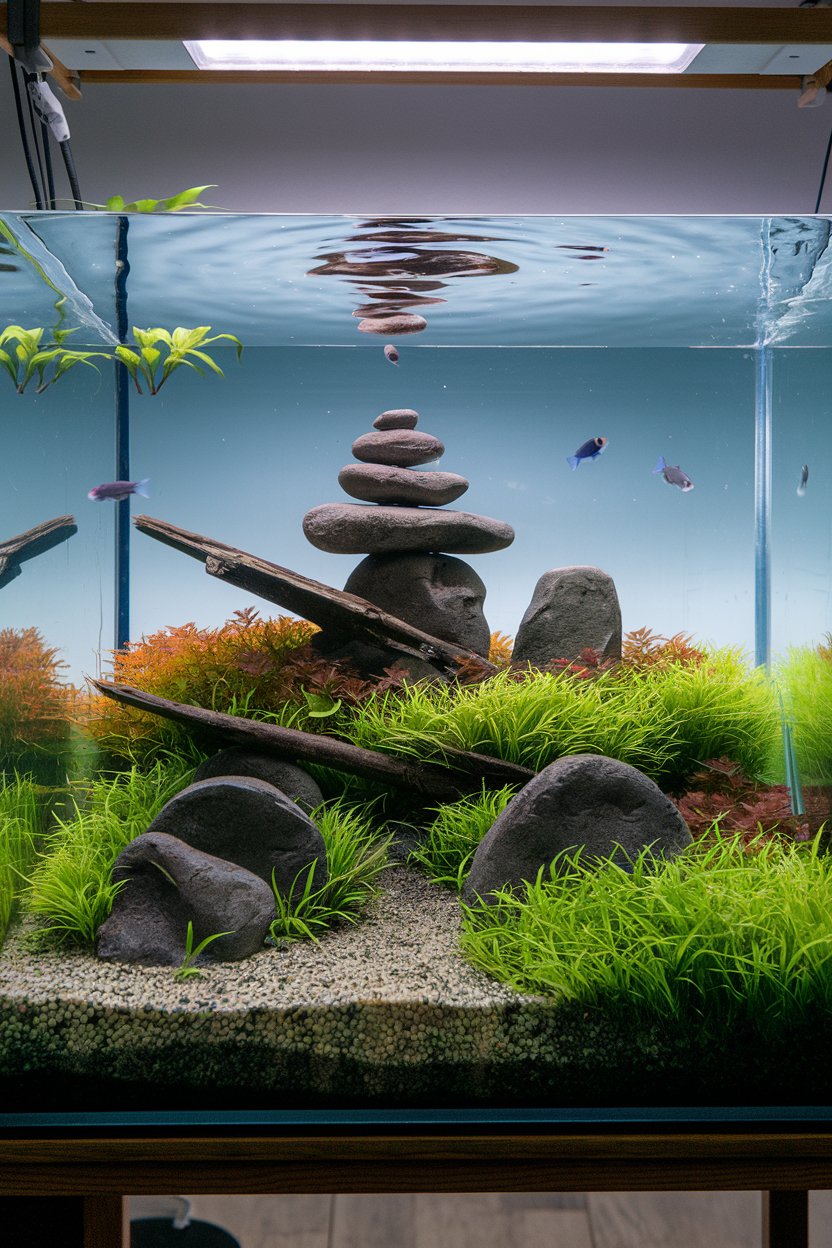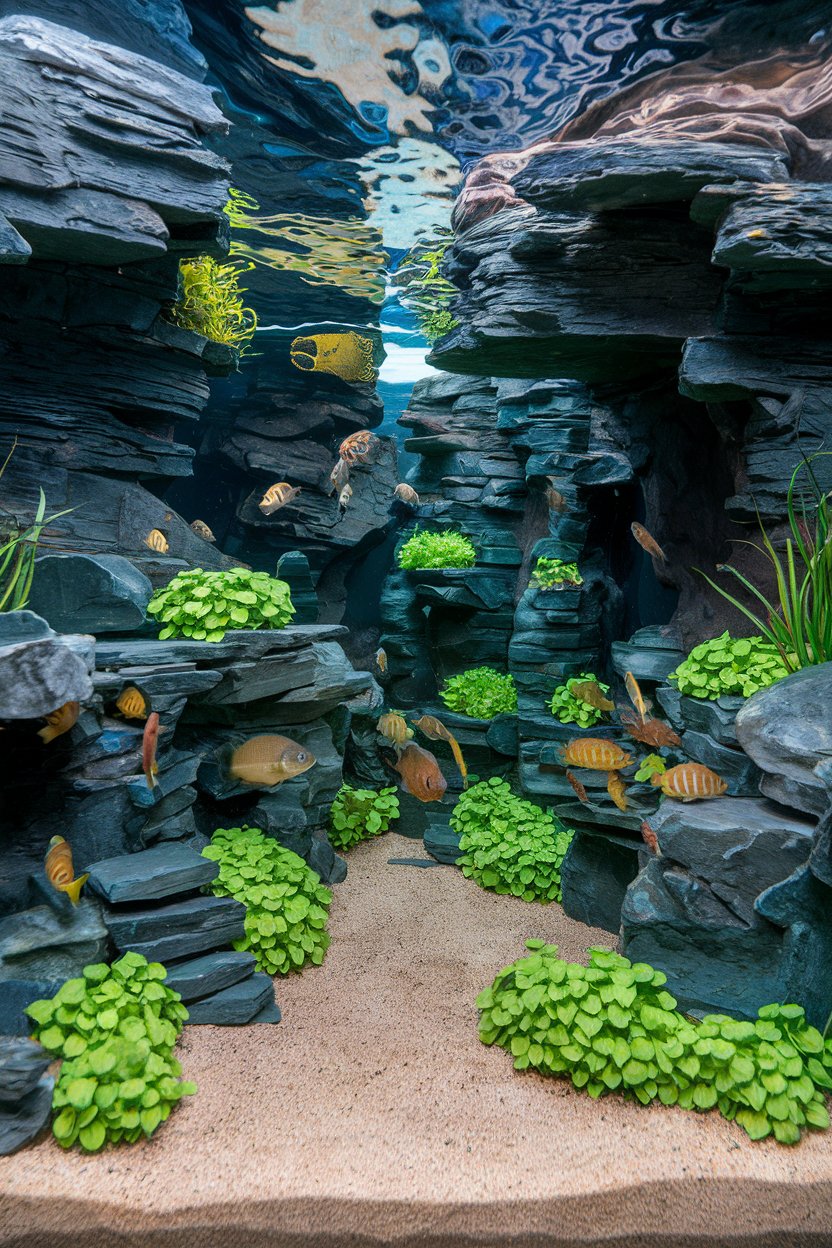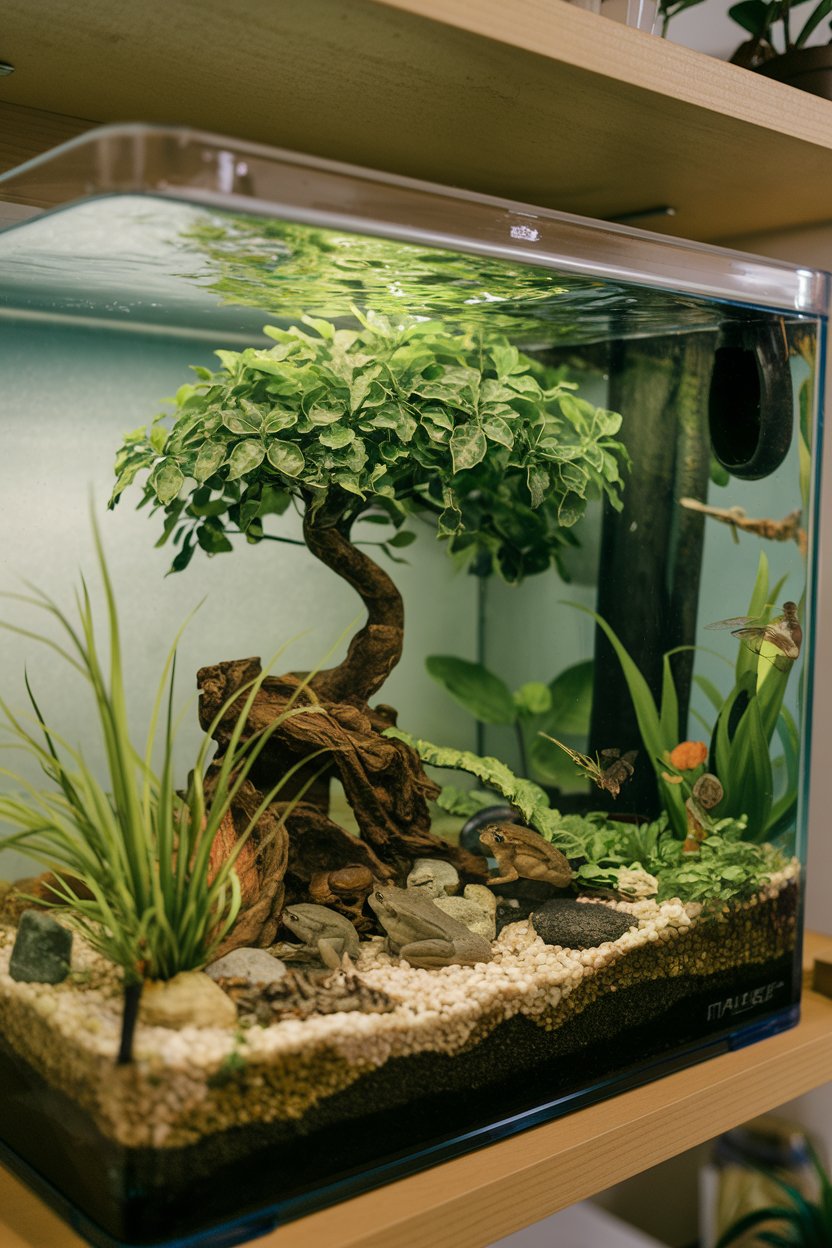15 Freshwater Aquarium Setup Ideas for Stunning Fish Tanks
Building a freshwater aquarium is more than just a hobby—it’s an art form. A well-thought-out tank can become a piece of living decor, a thriving ecosystem, and a calm retreat for both the fish and the keeper.
Here, we delve into 15 creative aquarium setup ideas that range from natural biotopes to imaginative themes. Each setup is designed to elevate your aquarium to new aesthetic heights while providing a healthy environment for your aquatic life.
15 Freshwater Aquarium Setup Ideas
1. Natural Riverbed Theme
The natural riverbed theme captures the beauty of river ecosystems in an aquarium setting. Begin by laying a substrate of small gravel or smooth river stones that resemble the natural textures of a river floor. Use various sizes of smooth stones and scatter driftwood, anchoring it in different spots to create a flowing, organic layout.
Add hardy plants such as Java moss, Anubias, and Vallisneria. This layout provides a balanced habitat for species like tetras, rasboras, and Corydoras, which thrive in a flowing river-like environment. To enhance the natural look, consider using a gentle water current to mimic a river’s gentle flow.
2. Lush Jungle Aquascape
The lush jungle aquascape is perfect for plant lovers who envision a thick, green underwater forest. Use nutrient-rich substrate to foster plant growth, and densely plant species like Amazon swords, Cryptocoryne, Java fern, and Vallisneria.
The goal here is to create a thick canopy of greenery, which offers ample hiding spots and a natural setting for your fish. Small schooling fish, such as neon tetras and dwarf gouramis, look stunning amidst dense foliage. Adding floating plants like frogbit or Amazon frogbit helps to diffuse light, giving the tank a mysterious jungle ambiance.
3. Minimalist Blackwater Aquarium
A blackwater aquarium captures the serene, low-light environment of South American and Southeast Asian rivers. Use a dark, fine substrate to enhance the visual effect of tannin-rich water. Adding natural materials like Indian almond leaves and driftwood introduces tannins, which create the signature amber color in the water.
To maintain the minimalist feel, keep plantings sparse; floating plants like Salvinia and water lettuce work well here, as do low-light plants such as Anubias and Java fern. Blackwater tanks are ideal for fish like angelfish, tetras, and dwarf gouramis, which naturally inhabit these environments.
4. Rocky Cichlid Habitat
Cichlids, particularly African cichlids, thrive in rocky environments that provide ample hiding spaces and territory divisions. Use a mix of limestone, slate, and smooth lava rocks to create stable rock formations, stacking them to form caves and ledges.
African cichlids, such as mbuna, are highly territorial, and these rock structures offer them natural boundaries and hiding places. A light-colored sandy substrate completes the look and mirrors the rocky lake environments of East Africa. Be sure to secure rocks carefully to avoid collapsing structures as cichlids can be quite active.
5. Zen Garden Aquarium
A Zen garden aquarium draws inspiration from Japanese rock gardens and emphasizes simplicity and balance. For the substrate, use white sand or light-colored gravel to create a clean and calming look. Arrange smooth stones and driftwood in harmonious positions to reflect the peaceful design of a traditional Zen garden.
Add a few plants—mosses and low-growing ground cover plants are ideal—and leave open spaces in the layout. This setup is best suited for peaceful fish like bettas and small shrimp, and its minimalist design makes for a relaxing viewing experience.
6. Biotope Aquarium
A biotope aquarium replicates a specific natural habitat in every aspect, from water conditions to plant life. Choose a theme, like a South American biotope, and use plants, rocks, and fish that would naturally coexist.
For instance, an Amazonian biotope might feature Amazon swords, Echinodorus plants, and species like Cardinal tetras and Corydoras. Adjust water parameters to match the natural conditions of the habitat, such as softer, slightly acidic water for Amazon biotopes. This setup not only creates a unique visual appeal but also allows your fish to thrive in an environment that closely mirrors their natural home.
7. Carpet Plant Aquarium
A carpet plant aquarium creates the illusion of a lush, green underwater lawn. Select plants that spread horizontally, such as Dwarf baby tears, Monte Carlo, or Java moss. For optimal growth, use high lighting and, if possible, CO2 injection to help the plants thrive and form a dense carpet.
These plants create a soft, visually pleasing carpet that serves as a perfect backdrop for small fish like guppies or shrimp. With proper care, the carpet effect adds depth and dimension to your tank, making it a focal point in any room.
8. Driftwood-Centric Setup
Driftwood is the primary feature in this setup, providing an eye-catching central structure. Select large, intricate pieces of driftwood and position them strategically to form a central “tree” or root-like design.
Attach epiphyte plants like Anubias, Bucephalandra, and Java fern directly to the wood to create a more natural appearance. Driftwood also helps soften the water by releasing tannins, which can be beneficial for fish like catfish and South American cichlids. This setup creates a rustic, forested look, reminiscent of submerged roots in a river ecosystem.
9. Iwagumi Style Aquarium
The Iwagumi style is a minimalist Japanese aquascaping technique that emphasizes simplicity and symmetry. It typically involves arranging an odd number of stones, often Seiryu or Ryuoh, as the main hardscape elements.
Use small carpet plants such as Dwarf hairgrass and Monte Carlo to cover the substrate around the stones, giving the tank a sleek and organized look.
This setup is ideal for showcasing small schooling fish, like neon tetras or rasboras, which add movement without detracting from the serene, orderly aesthetic.
10. Cave and Rock Formation
This setup focuses on creating caves and crevices, making it perfect for shy or territorial fish. Use lava rocks, slate, and granite to build stable formations that mimic natural underwater caves.
The dark crevices provide hiding spots for fish like plecos, loaches, and other bottom dwellers. Layer fine gravel or sand on the substrate to enhance the natural effect. Adding low-light plants like Cryptocoryne around the rock formations softens the hardscape, creating a balanced and visually appealing environment.
11. Dutch-Style Aquascape
The Dutch-style aquascape is all about vibrant, dense planting and contrasting colors. Use various plants like Rotala, Ludwigia, and Hygrophila to create layers and rows, simulating a garden-like appearance.
With this setup, a carefully planned layout with height and color contrasts is key. Fish play a secondary role in Dutch aquascapes, as the plants are the main attraction. Regular pruning and nutrient-rich substrate are essential to maintain the plants’ health and keep the garden look intact.
12. Paludarium Setup
A paludarium combines aquatic and terrestrial elements, creating a unique half-land, half-water environment. Design a section of the tank as an underwater area for fish and aquatic plants and leave space above for terrestrial plants.
Add small waterfalls or rocks for additional natural effects. This setup is ideal for amphibians, like frogs and newts, in addition to small fish. Plants like mosses, ferns, and Anubias thrive in these humid conditions, creating a jungle-like aesthetic.
13. Sandfall Aquarium
An underwater “sandfall” replicates the look of a waterfall using fine sand and an air pump. Arrange rocks and driftwood to create a natural sandfall area. Use an air-powered uplift system to carry fine white sand, creating a continuous cascade effect.
This eye-catching feature adds an unusual dynamic element to your tank, perfect for aquarists looking for something beyond traditional designs.
14. Betta-Specific Nano Tank
A betta tank should be small, cozy, and designed with plenty of resting places. Bettas love floating plants and soft leaves, so consider adding Anubias, Java fern, and floating Water lettuce.
A small piece of driftwood can serve as a resting spot near the surface, allowing your betta to feel comfortable and safe. The minimal current and gentle lighting make this setup ideal for these beautiful fish.
15. Sunken Treasure Theme
For a more whimsical approach, consider a sunken treasure theme. Use sandy substrate and incorporate ornaments like miniature shipwrecks, treasure chests, and smooth stones to simulate a sunken treasure scene.
This setup is a favorite for kids and brings a playful touch to any room. Add sparse vegetation to keep the focus on the themed decorations, and choose fish that thrive in such environments, like peaceful community fish or small shrimp.
Conclusion
Creating a beautiful freshwater aquarium setup is an enjoyable and highly customizable project. Each setup idea—from natural riverbeds and lush jungles to minimalist rock gardens and themed tanks—offers unique ways to showcase your fish and plants while building an aesthetically pleasing environment.
When setting up your tank, consider the specific needs of your fish species, the type of plants or decorations that suit the theme, and the care level you can commit to. With attention to detail and creativity, you can transform a simple tank into a thriving aquatic ecosystem that brings peace and beauty to any space. Dive in, experiment with these ideas, and watch your aquarium come to life!
- Sand Vs Gravel For Synodontis Barbels – The Ultimate Substrate - December 25, 2025
- Sudden Death Of Panda Corydoras Causes – Unraveling The Mystery & - December 25, 2025
- Corydoras Sensitivity To Salt And Copper – Essential Guide For - December 25, 2025

